The Rise and Fall of Ken-chan, the $43,000 Robot Waiter
The spaghetti-slinging robot drew crowds at Grazie’s Italian Restaurant in Tokyo
/https://tf-cmsv2-smithsonianmag-media.s3.amazonaws.com/filer/201206120140351987-march-11-pacific-stars-and-stripe-470x251.jpg)
While the robot waiters of mid-’80s Pasadena were serving up chow mein at the Two Panda Deli in sunny California, another robot waiter 5,400 miles west was slinging spaghetti at Grazie’s Italian Restaurant in Tokyo.
Released in 1985 by the Japanese company Daimichi Koki with software designed by the Seibu Saison Group, Ken-chan was a 4-foot-tall robot waiter that buzzed around Grazie’s, helping most often with the wine selection. Ken-chan was supposedly guided by a radar senor that was intended to detect other objects around it and maneuver within the tight confines of a restaurant. However, the robo-waiter was far from autonomous, needing to be led around the restaurant by humans who used a remote control with a 12-foot cord.
Ken-chan couldn’t take orders or even set food on a table, but it did attract a crowd. Off the shelf, the metal server could utter just 15 different phrases in Japanese including “My name is Ken” and “How about dessert?”–but you could add the “Happy Birthday” song to its repertoire for an additional $425.
One of the restaurant’s managers, Kenichi Echiuya, first spotted the robot waiter at the 1985 World’s Fair in Tsukuba, Japan (known as Expo ’85). Ken-chan cost $43,000 (about $86,000, adjusted for inflation) and the early news stories about it were pretty glowing. An article in the September 12, 1985 issue of the military newspaper Pacific Stars and Stripes in Tokyo explained the novelty:
Anybody who’s in the mood for Italian food served with a unique flare should try a new restaurant called Grazie in Tokyo’s Ropongi district.
When it comes time for wine or the fruit or dessert course, you might find yourself looking not at a pretty waitress or handsome waiter, but at a $43,000 robot named “Ken-chan.”
A 1986 Associated Press article quotes the restaurant’s manager as saying that even if the robot isn’t very practical as a server, it certainly is good for business:
“Some people come in and order just a cup of coffee or tea to see the robot,” said Kenichi Echiuya, manager of Grazie’s and three other restaurants at the same location.
“This is a family restaurant, and the children especially love to see him,” he says. “He brings in customers.”

Ken-chan the robot waiter (September 12, 1985 Pacific Stars and Stripes)
But by 1987 Ken-chan had become a symbol of overblown robot hype. The robot bubble, it seems, had burst. At least when it came to the hope of replacing human waiters. From the March 11, 1987 issue of Pacific Stars and Stripes:
Scientists are predicting that labor-saving robots will revolutionize the industry in the 21st century and free millions from the drudgery of menial service jobs.
Restaurant manager Mitsugu Watarai, however, is taking those forecasts with a grain of salt. He attempted to introduce a mechanical waiter at his Grazie Italian Restaurant in the Ropongi entertainment district and calls the idea “impractical.”
The Pacific Stars and Stripes piece ends with a particularly depressing visual — the robot waiter relegated to the corner of the restaurant, waiting for a future that may not be quite as spectacular as we were promised.
Ken-chan now gathers dust in one corner of the restaurant, waiting for technology to catch up with the complexities of waiting tables. His inactivity is seemingly mute evidence that the 21st century and the golden age of robots might be a lot more than 13 years away.
/https://tf-cmsv2-smithsonianmag-media.s3.amazonaws.com/accounts/headshot/matt-novak-240.jpg)
/https://tf-cmsv2-smithsonianmag-media.s3.amazonaws.com/accounts/headshot/matt-novak-240.jpg)